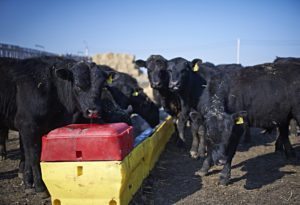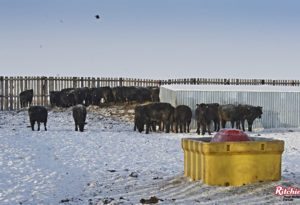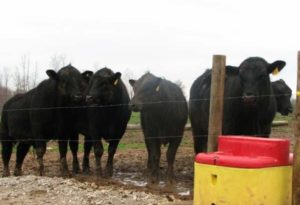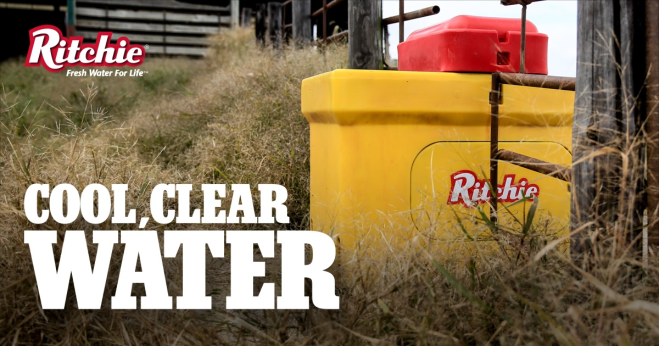Improve Water Quality for Better Cattle Health
Water quality can affect land and cattle productivity
 Let’s face it, cattle are naturals at drinking as long as there is a water source and access. What else is there to think about?
Let’s face it, cattle are naturals at drinking as long as there is a water source and access. What else is there to think about?
The importance of water deserves the time and attention of cattle producers. Cattle simply cannot be healthy and gain well without good quality water. It pays to give this fundamental need a checkup. What’s more, ensuring pastures have a high-quality, sustainable and uncontaminated water source is a key component to environmental stewardship.
Check the Temperature
Water deprivation caused by high temperatures is usually accompanied with lack of green forage. In the absence of drought conditions, fresh forage can actually supply some of the daily water requirements for grazing cattle. Without adequate grazing, this situation can quickly lead to dehydration when producers consider that a healthy heifer can drink up to 20 gallons each day in the warmer months, according to the Texas A&M Veterinary Medical Diagnostic Laboratory.
Streams and ponds contaminated with green algae, parasites or other contaminants can all discourage the animal to fully hydrate. In drought conditions, many surface water sources evaporate completely or are so stagnant the animals refuse to drink.
In winter months, water temperature is still an issue. In the case of surface water and large-volume tanks, freezing also is a constant problem. Even if the water source is not frozen, water at, or near, freezing is not palatable for the animals. This can cause lower levels of hydration in the winter too and result in stress. As we all know, stress can lead to disease and other issues that may require a vet visit.
Contaminants and Stagnancy
Cattle will make the same choice as humans if given the option of a clear, cool glass of water or a smelly, murky warm drink. Ground water supplies inherently collect concentrations of fertilizer, herbicides, feces, urine and algae growth. Large-volume troughs are also breeding grounds for bad bacteria, mosquito larvae and attract other rodents or animals that can cause issues as well. Cattle producers should have a plan in place for keeping contaminants out of water sources and reducing sources that can become stagnant before extreme heat or cold arises.
 Animal Hydration
Animal Hydration
Severely dehydrated cattle show signs including sunken eyes, dry mucus membranes and reduced dry matter intake. At just 7 to 10 percent dehydration, cattle can experience impaired immune systems, according to Robert Ovrebo, DVM.
Automatic watering is a solution for eliminating the common instances of dehydration. Automatic waterers are designed and built for this exact purpose: to make sure animals have temperate, clean water on demand. The purpose of the automatic waterer is to guarantee access to a clean water source. Automatic waterers are able to mitigate the instances of disease caused by water borne contaminates, lack of access to fresh water and the under hydration that occurs when the water source is foul or the temperature is too hot or cold.
Environmental Stewardship
Automatic waterers, by design, eliminate waste. Large troughs create stagnancy and displace water when they are cleaned. Cleaning troughs can also be a labor-intensive job. In addition, these large troughs evaporate at a surprisingly fast rate. When choosing a watering solution, the footprint of the source and the amount of waste created should be a consideration.
Taking animals off of ponds and streams also has a positive effect on the land and the rest of the ecosystem that it supplies. The value of the land and producers’ ability to manage these resources work together in producing a thriving enterprise. A comprehensive watering strategy should consider:
• Animal health
• Land management and
• Environmental stewardship.
 Water quality is the foundation for how cattle genetics, health, feeding and management strategies will either succeed or fail. Keeping cattle hydrated with the right mix of electrolytes is essential to an operation’s success. Conserving resources helps do this efficiently and preserve resources for other areas of the operation.
Water quality is the foundation for how cattle genetics, health, feeding and management strategies will either succeed or fail. Keeping cattle hydrated with the right mix of electrolytes is essential to an operation’s success. Conserving resources helps do this efficiently and preserve resources for other areas of the operation.
Ritchie waterers offers a range of automatic waterers that will suit a variety of needs. To locate your local Ritchie dealer visit our Dealer Locator. Dealer Locator.
###
Sources:
Texas A&M Veterinary Medical Diagnostic Laboratory. How to keep your cattle hydrated and healthy during a drought. Available at: https://tvmdl.tamu.edu/wp-content/uploads/2012/07/TVMDL-water-salt-intoxication-handout-8.12.pdf.
Ovrebo, Robert G. Bovine hydration. Drovers CattleNetwork. Jan. 17, 2011. Available at: http://www.cattlenetwork.com/bovine-vet/bv-magazine/bovine-hydration-113983004.html
